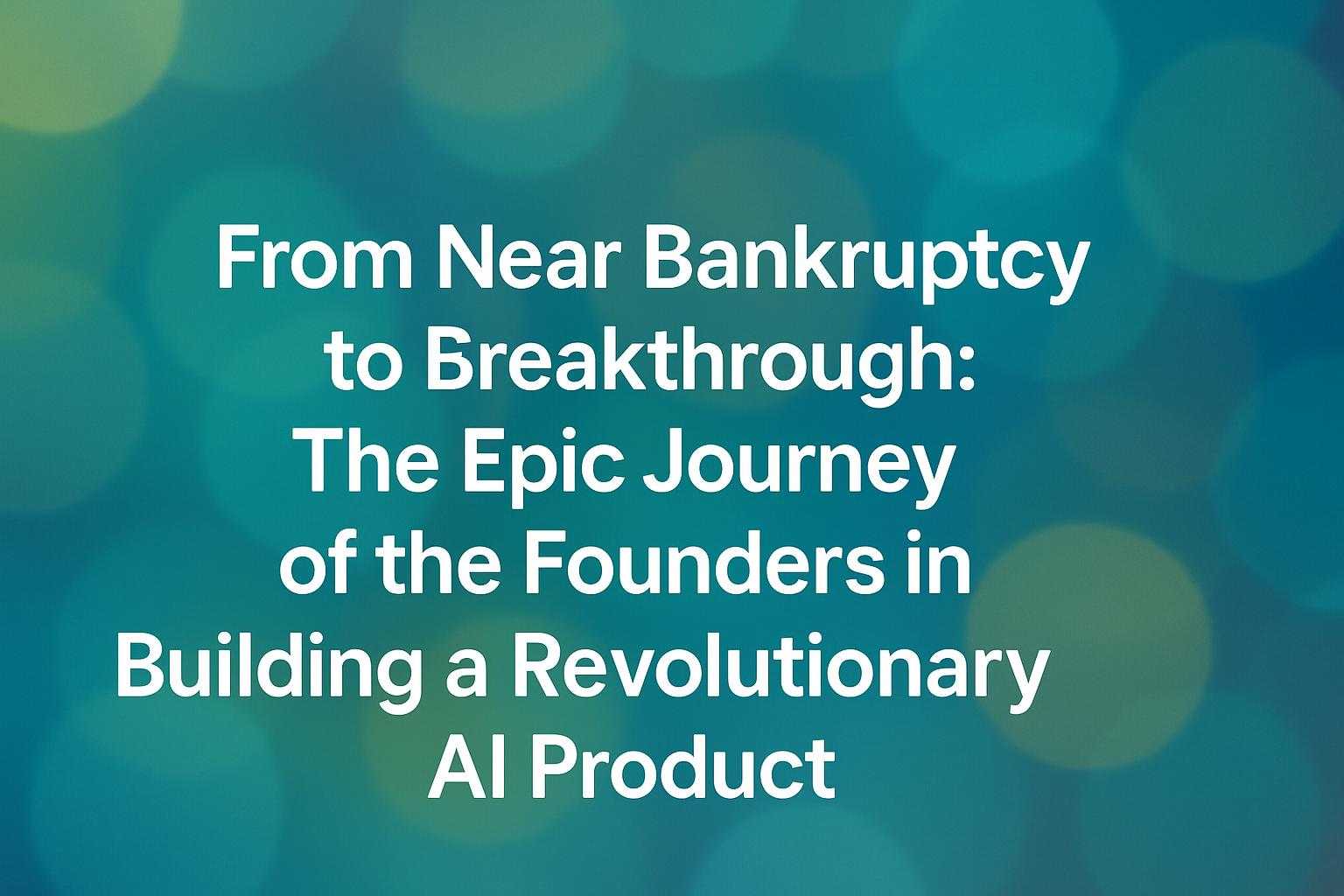Bolt: From Near Bankruptcy to Breakthrough: The Epic Journey of the Founders in Building a Revolutionary AI Product

Company profile
Company business details
Motivation to build the product
Founders Eric Simons and his co‑founder spent seven years developing WebContainer technology at StackBlitz to run full dev environments in the browser, but struggled to find a commercial application. When Anthropic released the Sonnet model capable of reliable zero‑shot code generation, they realized their browser OS was an ideal fit for an AI‑first development platform. This insight inspired them to rapidly build Bolt on their existing deep‑tech foundation to solve the persistent problem of development setup and iteration friction.Problem that their product solves
Bolt addresses the slow, complex workflow of traditional software development, where setting up environments, drafting specs, and waiting on engineers can take days or weeks. Its end users—product managers, designers, entrepreneurs and small businesses—often lack coding expertise but need rapid, cost‑effective prototypes and production apps. By automating environment provisioning, code generation and deployment, Bolt cuts development time and costs by over 90%, enabling non‑technical teams to go from idea to live application in minutes.How they developed a primary version
After prototyping Bolt in two weeks in early 2024 (which was limited by immature AI models), the team shelved the idea until Anthropic’s Sonnet model arrived. They green‑lit the project on July 1, 2024 and built the public version of Bolt in roughly 90 days. All core components were developed in‑house by the founders and existing StackBlitz team, with weekly live community streams to gather feedback and iterate features.Their unfair advantage
Bolt’s proprietary WebContainer tech runs an OS and dev environment in the browser using local compute—eliminating server costs, latency and reliability issues of cloud VMs. Combined with early access to state‑of‑the‑art AI code models and a small, long‑tenured team deeply versed in browser OS engineering, Bolt delivers unmatched speed, reliability and a generous free tier.Strategies
Pre-Launch (Product Development & MVP)
Developer Evangelism through Early Access Preview
During the pre‑launch phase, Bolt secured early preview access to cutting‑edge AI models (e.g., OpenAI’s Sonet) to prototype rapidly. By building on the newest models before competitors, the team positioned Bolt as a first mover and created buzz among technical audiences. (OpenAI)
Launch Stage
Twitter Launch & Viral Thread
Bolt’s co‑founders bypassed traditional PR and announced the product with a single Tweet on launch day, generating tens of thousands of sign‑ups and over $60 K in ARR within 24 hours—without paid ads. A follow‑up multi‑tweet thread (with a short video demo) then went viral across Twitter, Hacker News and Reddit, driving widespread word‑of‑mouth adoption and the first millions in ARR.
Freemium Product‑Led Growth (Launch)
On day one, Bolt opened the product under a frictionless free tier—no credit card or signup barriers—so anyone could instantly spin up a full‑stack app in their browser. This low‑friction onboarding fueled rapid word‑of‑mouth sign‑ups, with users upgrading only once they’d proven the tool’s value.
Podcast Guest Appearances
Bolt’s founders appeared on developer‑focused podcasts to demo the product, share their seven‑year evolution story, and reach a targeted audience of builders. Live coding segments on these shows demonstrated real‑time capabilities and drove immediate sign‑ups.
Strategic Partnerships & Co‑Marketing
Bolt formed integrations and co‑marketing relationships with complementary platforms—Expo for mobile builds, Supabase for databases, and Netlify for web hosting. By embedding into established toolchains, the team tapped into existing user bases and benefited from partner promotion.
Live Coding Demonstrations & Showcases
Bolt hosted live coding demos—both virtually on podcasts and in‑person—to highlight how quickly the platform could generate full‑stack web and mobile apps from text prompts. Seeing the product in action converted skeptics and drove trial sign‑ups.
Growth Stage
Freemium Product‑Led Growth (Scale)
Bolt offers a very permissive free tier that runs entirely in the browser on each user’s CPU—no always‑on cloud VMs or API hosting costs. By removing hosting friction, the team dramatically lowered acquisition barriers, encouraged rapid trial and sharing, and scaled its user base without direct server investment.
Integration Marketing via Figma Partnership
Bolt built a native integration that takes any Figma URL and instantly converts it into a deployable full‑stack or mobile app. By tapping into Figma’s massive designer community, Bolt gains exposure to tens of thousands of new prospects every day who want one‑click prototypes and production code. (Figma)
Integration Marketing via Slack Bot
Bolt developed a Slack‑based agent so teams can spawn new web or mobile apps directly from chat threads. By embedding into the primary communication channel of PMs and engineering teams, Bolt becomes a utility that fits naturally into existing workflows. (Slack)
Affiliate & Bundled Subscription Incentives
Bolt’s host newsletter offers an annual paid plan that bundles free annual subscriptions to partner services (e.g., Perplexity Pro, Notion, Linear, Granola, Superhum). This cross‑promotion captures higher‑value subscribers and drives traffic to affiliate partners in one package.
Podcast Sponsorship Ads
The team sells host‑read ad spots on their podcast to companies like EPO, Fundrise, and One Schema. Each spot positions the sponsor’s solution, highlights use cases and customer testimonials, and ends with an exclusive promo link or code to drive measurable conversions.
Social Media Meme Marketing
Bolt shared humorous, developer‑oriented memes (for example the Jeff Bezos overlooking growth charts meme) on Twitter. This light‑hearted content captured attention, encouraged retweets, and expanded brand visibility organically among the target community.
Open Sourcing Core Prompts
Bolt released its system prompts and key integrations as open source, inviting the developer community to self‑host, tinker, and contribute. This transparency built trust, accelerated R&D, and generated advocates who promoted the product in their own networks.
Product‑Led Growth through Exceptional In‑Browser Experience
Bolt invested in a proprietary in‑browser OS environment that boots in ~100 ms, works offline, and avoids per‑user cloud VM costs. The instant feedback loop, reliability, and low latency became its own best marketing: satisfied users told their peers.
Community Building via Live Office Hours & Discord
Rather than one‑way marketing, Bolt instituted weekly live “office hours” livestreams and built an active Discord server as a community hub. The team personally answered questions, gave real‑time demos, recognized top contributors, and turned members into advocates and peer‑to‑peer support.
User‑Generated Content Promotion
Bolt encouraged customers to publish tutorials, demos and success‑story tweets on YouTube, TikTok and Twitter. The company amplified this content—retweeting, sending swag or T‑shirts to authors—and spotlighted use cases as social proof, accelerating trust and adoption.
Co‑Marketing Case Study with AI Partner
Bolt collaborated with their API partner Entropic to produce a deep‑dive case study titled “Zero to $4 M ARR in Under Four Weeks.” This joint success story highlighted both the AI model’s power and Bolt’s usability, lending credibility, generating developer interest, and driving inbound sign‑ups.
Stealth PR & Selective Fundraising Announcements
Bolt avoided hype cycles by waiting until a new funding round closed before publicly announcing the prior round. They also timed disclosures (e.g. $4 M ARR) conservatively to manage expectations and sustain momentum without distraction.
Open Source Distribution of Core Editor
Bolt open‑sourced its core editor (bolt.diy) to give developers and labs a production‑like testbed. This transparency increased credibility, encouraged experimentation by AI model teams, and created a broader ecosystem of integrations—lifting overall awareness and product familiarity.


